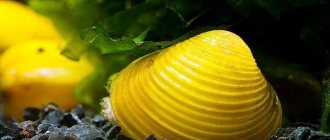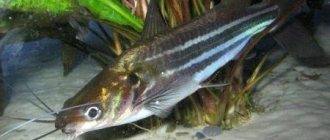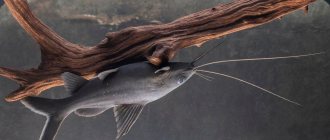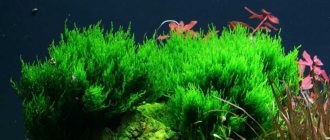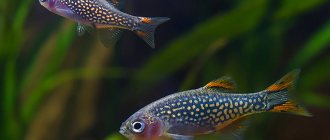Along with the toothless and barley, in freshwater bodies of water you can often find the charcoal. These small mollusks live almost everywhere: in Europe, Asia, America and Africa.
The Horny Sharovka, which lives in Europe, is otherwise called the nail-shaped mollusk.
The Latin name of this genus, Sphaerium, fully corresponds to the Russian, both of them are associated with the round shape of the mollusk shell. All types of balls are quite modest in size: even the largest individuals barely reach 3 cm in diameter. However, they have even smaller close relatives - peas, very similar to them in structure and way of life. The size of these little ones is only 5 mm.
Corbicula java
Javan Corbicula photo
Corbicula, golden bivalve or yellow Javan baller (Corbicula Javanicus) is common in the wild in the countries of Southeast Asia. This tropical bivalve mollusk lives in fresh water bodies of China, Indonesia and Vietnam. A related species, Corbicula japonica, is widespread in Japan. These are bottom-dwelling mollusks. Half buried in the ground, they filter water, absorbing various suspended organic particles.
Optimal parameters for keeping corbicula: temperature 22-27 ° C, pH 6.4-8.5, gH 10-24. Like any aquatic organisms, these snails cannot tolerate high concentrations of nitrogenous compounds - poisons: ammonia, nitrite and nitrate . In general, they are undemanding to the quality of water in the aquarium, but there must be good oxygen saturation of the water, which means aeration in the aquarium is mandatory. Corbicula grow up to 3 cm in size. Life expectancy: 4 - 7 years.
Javan Corbicula photo
The recommended soil is sand with a fraction of 1-3 mm; the corbicula are buried almost entirely in it. The soil layer should be at least 2-3 cm. Corbicula can be kept with all peaceful fish and shrimp. For obvious reasons, snails should not be kept with tetraodon , labyrinth and other fish that are not averse to feasting on them.
Javan Corbicula photo
Corbicula are excellent helpers in an aquarium against water cloudiness, as they are filter feeders.
By passing water through themselves, they feed on the microorganisms contained in it. According to various sources: someone recommends keeping one corbicula per 100 liter aquarium. There is information about keeping two or even three individuals in 20 liters. It is recommended to keep such mollusks in spawning grounds, where the need for clean water is especially important. Corbicula passes through itself 5 liters of aquarium water per hour! In aquariums where ball snails live, the water is always crystal clear, does not bloom and does not have suspension or turbidity!
With that said, if the parameters of nitrogen compounds in your aquarium are ideal, and there are a lot of corbicula, they can be fed, sinking tablet food, for example, Tetra Tablets TabiMin or Tetra Pleco Tablets, is best suited for this purpose.
An interesting fact is that in aquariums containing corbicula, ichthyophorosis diseases do not occur; according to aquarists, corbicula trap ichthyophthirius cysts, which float in free flight.
Corbicula are hermaphrodites, there are no problems with reproduction in the aquarium. Corbicula are viviparous, producing tiny snails that are barely visible to the naked eye. In the aquarium, newborn corbicula look like a cloudy cloud, then sink to the bottom, where they continue to grow and develop.
If your aquarium contains plants with a weak root system, then the corbicula, plowing the soil, can easily dig them up.
Javan Corbicula photo
All of the above is just the fruit of observing this aquatic organism and collecting various information from owners and breeders. We would like to share with visitors not only information, but also live emotions that allow us to understand the world of aquariums more fully and subtly. Register at https://fanfishka.ru/forum/ , participate in discussions on the forum, create profile topics where you will talk about your pets in the first person and first-hand, describe their habits, behavioral features and content, and share with us your successes and joys, share your experiences and learn from the experiences of others. We are interested in every bit of your experience, every second of your joy, every awareness of a mistake, which makes it possible for your comrades to avoid the same mistake. The more of us there are, the more pure and transparent drops of goodness there are in the life and everyday life of our seven billion society.
Ampularia - yellow aquarium snail
YELLOW AMPULARIA SNAIL IN YOUR AQUARIUM
This yellow ampullaria snail is well known to any aquarist. Perhaps only a novice lover of the aquarium world, entering a pet store, wonders about this yellow, creeping inhabitant of the aquarium.
This article will help expand information about this yellow snail - the “aquarium orderly”. In it you will find answers to many of your questions. So,…..
Briefly about the most interesting things about ampularia:
— The concept of ampularia includes a whole family of freshwater snails, divided into genera and living all over the world.
— Ampoule sizes from 5 to 15 cm.
— Yellow snails live 1-4 years (depending on water temperature and other conditions).
— Comfortable water temperature for ampoules is 22-24C and above. By the way, this temperature of aquarium water is comfortable for many aquarium fish, so there are simply no difficulties in keeping them together. On the contrary, there are only advantages from such a symbiosis.
— Snails breathe atmospheric air through a siphon tube, but also have gills.
— Ampullaria snails are heterosexual.
— The snail has a cover at the mouth of the shell, which is necessary for protection from aggressors and for waiting out unfavorable conditions.
— If there is little calcium in the aquarium water, the yellow shell of the ampoule will collapse.
— When buying snails, it is better to take small-sized ampularia. Firstly, the larger the snail, the older it is, which means it will live with you less, and secondly, small snails are much faster than adults.
Description of the yellow snail - Ampularia:
Keep the ampoule in a regular aquarium with fish. The snail is compatible with many types of fish, but it should be taken into account that some fish try to pinch their whiskers, and some fish feed on mollusks. Therefore, I recommend keeping ampullaria with peaceful and non-aggressive fish, and if in doubt, consult with pet store sellers. Personal experience suggests that ampullaria do not live long with gouramis and some cichlids (since the latter simply do not allow the snails to breathe). Sometimes even seemingly harmless goldfish bite yellow snails. What to do about it? You have two options: either plant the ampullaria, or leave them to feed the fish. If you notice that the ampullaria snails are being “oppressed” and do nothing, you should know that the yellow mollusks have 1 week left to live...
Editor's note: A huge lobster was caught in the USA
The aquarium can be of minimal size, the main thing is that it has a lid. Otherwise, one night, walking to the kitchen, you may hear a characteristic crunch under your feet!!!
You should also take care of the air space under the lid. Firstly, snails breathe atmospheric air. And secondly, ampularia, as a rule, lay eggs in the air space (for this, the distance between the lid and the water should be at least 10 cm).
Unlike many fish, apple apples are not fussy to keep. And water parameters don’t really matter. When keeping fish, you install a filter for them in any case and, as a rule, if you are not lazy, regularly replace some of the water with fresh water - this is quite enough for the ampoule.
What you should pay attention to is the calcium content in the aquarium water; if it is low, the ampoule shell will collapse. I scattered small seashells in my aquarium, which helps saturate the water with calcium and increases its hardness.
It is also recommended to add marble chips and limestone chips; in addition, pet stores have special preparations to increase water hardness.
Regarding nutrition, I don’t personally feed my apple apples, because... they are actually omnivores and are content with the remains of fish food, plants, etc. By the way, ampullaria are excellent aquarium orderlies; they do not hesitate to “suck on” dead fish and other dead organic matter. They love rotten banana peels.
Regarding breeding. The incentive for mating is increased temperature in the aquarium and good nutrition. As a rule, yellow snails are used for this, since it is virtually impossible to distinguish the sex of the snail.
Well, then... one fine morning on the wall of the aquarium or the lid you will find a clutch of eggs that the female laid at night.
After about three weeks, the first baby snails emerge from the eggs and, by eating the clutch, secure their way to freedom.
It is advisable to remove the babies from the general aquarium, because... some fish don't mind trying them for dinner. In order not to catch the emerging young, some aquarists transfer the clutch to a separate aquarium in advance (the clutch is wetted, carefully moved and transferred).
Well, then, small ampularia are completely independent. Particularly caring owners initially feed them with crushed fish food.
Corbicula java, bivalve mollusk in aquarium
Photo: bivalve mollusk Corbicula java.
Bivalve molluscs are quite rare in freshwater aquariums. More recently, aquarium enthusiasts have acquired a very interesting and very beautiful mollusk - the Javan corbicula or golden bivalve. This animal can not only become a decoration for an indoor pond, it brings tangible benefits by maintaining the purity of the water.
LOCK WITH TEETH
Shark shells can be oval or ovoid, but most often they are spherical and look like a hazelnut. Scientists believe that in the distant past they were solid - this is indicated by the presence of a ligament. The walls of the shell are quite thin and consist mainly of calcium carbonate.
Each valve has a clearly visible protruding tubercle - the crown, located closer to one of the edges. This edge is called the dorsal, upper or key edge. There is a lock there that prevents the sink doors from moving. It consists of teeth and corresponding recesses. The lock structure is an important feature for the classification of bivalve mollusks. In some species it is equal-toothed (it is also called taxodont), while in others it is heterodont. It is to the latter category that the balls belong.
Appearance of the bivalve mollusk "Corbicula java"
Photo: Javan corbicula bivalve mollusk, overall dimensions.
Corbicula java is a small snail, which makes it suitable for keeping in an aquarium. The size of the shell of an adult snail does not exceed 3 cm, young specimens are somewhat smaller - about 1 cm. The shell of the corbicula is bivalve, round in shape. Golden bivalves have a bright yellow color, so they look very elegant in aquariums.
Mollusks are active during daylight hours. Burying into the ground and exposing part of the sink with a siphon to the surface, they open the doors to filter water. At night, their valves are closed, the mollusks are at rest.
Aquarium cleaners and orderlies - useful fish, shrimp, snails that get rid of algae
Who benefits in the aquarium?
Every aquarist, sooner or later, has this question. First, we purchase unpretentious fish that are easy to keep. We are gradually becoming interested in more complex fish, more interesting and rare. We often choose fish based on the beauty of their color, shape, and behavior. But, there comes a time when we are looking for useful fish, even if not so bright and interesting in behavior, but which make it easier for us to take care of our aquarium world, which clean the aquarium, are its orderlies and bring unconditional benefits!
So, let's begin. Healthy fish that immediately come to mind include: Siamese algae eaters (SAE) and their relatives
Otocinclus
Ancistrus
Algae-eating snails and orderlies
Helena snail
Predatory snail-eating snail. Thunderstorm of all snails!!!
Next, I would like to dwell in more detail on some snails. Neritina snail “Zebra” “Neritina natalensis sp “Zebra” Neretina snail “Hedgehog” “Neritina juttingae” Neretina snail “Black Ear” I would also like to dwell on a tiny snail - Horned snail Neritina Clithon Septaria porcelain (Septaria porcellana) Attention: Septaria also hangs its caviar on the decorations. And these mollusks interested me very much!! And it all started with this photo: Javan Corbicula snail (Corbicula javanicus) or yellow Javan harem or golden bivalve FanFishka.ru thanks . author of the article - Esta (Natalia Polskaya), for the material provided and cooperation!
author of the article - Esta (Natalia Polskaya), for the material provided and cooperation!
fanfishka.ru>
Keeping Javan Corbicula in an aquarium
For corbicula, a tank with a volume of at least 10 liters is selected. These snails are very unpretentious. They are undemanding to the composition and quality of water. To maintain Javan corbicula, the temperature can be maintained within 15-30 degrees, and the water parameters can be as follows: pH 6.4-8.5, gH 10-24. Lighting also doesn't matter much to them. The only prerequisite for successful keeping and breeding of bivalve mollusks is a sufficient amount of oxygen in the water. Therefore, aeration in a reservoir with these mollusks is mandatory.
Photo: Javan Corbicula, in an aquarium.
In an aquarium with Javan corbicula, it is necessary to have medium-sized soil. These can be small pebbles or washed river sand. It is important that these mollusks are able to burrow into the ground, so large stones are not suitable for them. The soil layer should be at least 3 cm, but not too thick. These bivalves spend most of their time buried in the ground, and sometimes they move slowly, leaving behind a small groove in the sand. They feed on various microorganisms and algae, waste products of other inhabitants of the aquarium, and small particles of food. They eat pathogenic bacteria and protozoa that can harm the fish population of the aquarium. Therefore, diseases of aquarium fish are usually not observed in tanks with Javan corbicula.
Sturisoma
These aquarium cleaning fish belong to the chain catfish family. The body is oblong, flattened. The caudal fin is 1.5 times longer than the body.
Characteristics:
- The dorsal fin is sickle-shaped.
- The caudal fin has the outline of a two-pronged fork.
- Dark brown side stripe from tail to eye level.
Sturisomes grow up to 20–30 cm. Their lifespan in aquariums is 6–9 years. Absolutely not aggressive. The complexity of the content is basic. The volume of the breeding tank is from 120–150 liters. Activity occurs at night. Omnivorous.
Varieties of sturisom:
- Golden.
- Yellow.
- Festivum.
- Frenatus.
- Lyra.
- Black-snouted.
Do you like catfish from the chainmail family?
Reproduction of the bivalve mollusk "Corbicula java" in an aquarium
Photo: bivalve mollusk Corbicula java, in a spawning area. When breeding shellfish, it is advisable to feed them, for example, add “Artificial Plancton” once every three days, and once a week Infusorienhaushalt bacteria with a small amount of sugar.
In aquarium conditions, the golden bivalve lives and reproduces well. She reproduces twice a year - in autumn and spring. These mollusks are hermaphrodites. For reproduction, it is better to plant about 20 mollusks in a tank. The aquarium should have a volume of about 50 liters, the water temperature should be 24 degrees. A layer of sand at least 2 cm thick is placed on the bottom.
Unlike many other species of bivalve mollusks, Javan corbicula larvae do not parasitize fish. One Javan corbicula produces up to 2000 larvae, which are up to 1 mm in size. They float in the water column for 24 to 48 hours, after which they settle to the bottom and gradually develop into a bivalve mollusk. Therefore, even when breeding in a common aquarium, these bivalves do not harm the fish. Fish can eat larvae in the first days of their life, so for successful breeding it is necessary to place the mollusks in a separate tank.
The minimum bet in European roulette is 1 ruble, all games with fairness control.
Devil's thorn video review
An interesting video story about theodoxuses -
panaceas for algae
+
Subscribe to our YouTube channel so you don't miss anything
Category: Aquarium articles / Aquarium snails | Views: 11,621 | Date: 19-08-2018, 19:05 |
We also recommend reading:
- — Spixies are aquarium elves!
- — Echinodorus "Red Devil"
- — Echinodorus Nazgul
- — Echinodorus "St. Elmo's Fire"
- — Echinodorus Dark Beauty
Pros and cons of aquarium snails
Keeping snails in an aquarium has its advantages and disadvantages. Advantages of living in aquarium conditions:
- Mollusks perform sanitary functions. They eat leftover food from aquarium fish, decomposed parts of plants, and some species eat dead fish.
- Snails remove green plaque on the walls of the aquarium and plants, and are able to feed on filamentous algae.
- The shellfish are interesting to watch. Their leisurely movements calm the nervous system.
- Aquarium snails serve as an organic element of the closed ecosystem of the aquarium, adding naturalness to it.
- Some varieties like to burrow into the soil, thereby enriching it with oxygen. This prevents the production of hydrogen sulfide and the appearance of a musty smell. (Melania)
- Aquarium gastropods are a kind of indicator of water composition. When there is a lack of oxygen, they rise to the top. Shellfish do not do well in soft water with a lot of nitrogen compounds.
- Some species filter aquarium water, improving its quality. (Corbicula)
- Some aquarists use snails as live food for predatory fish species.
In some cases, mollusks in aquarium conditions can be harmful. Cons of the content:
- Many species of aquarium snails eat aquatic plants, especially young tender shoots. Most often, this happens during intensive population reproduction, when gastropods begin to run out of food.
- The shells of dead mollusks, decomposing, change the chemical composition of the aquarium water.
- Snails are capable of eating fish eggs.
- The mucus secreted by gastropods can cause cloudy water.
- The population of aquarium snails must be kept under control: as a result of rapid reproduction, their number can become so large that they become the masters of the aquarium. They eat plants with lightning speed, depriving the fish of sufficient oxygen.
Mollies
The fish are aquarium cleaners of the poeciliaceae family, ovoviviparous. The body is oblong, narrowed laterally. The fins are mostly short, the tail is rounded. Not picky about living conditions, resistant to diseases. Viviparity has made mollies very competitive.
Dimensions 4–10 cm. Live in aquariums for up to 4–5 years. The character is non-aggressive. Behavior is active. Diet type: omnivore. They can reproduce both in a separate tank and in a common container.
Selective processing has led to the emergence of a fairly wide variety of these fish. Differences:
- According to body shape.
- Color.
- Shape and size of fins.
4 main varieties of mollies:
- Sphenops. Small fins.
- Latipina. Developed dorsal fin and forked tail.
- Velifera. Large dorsal fin.
- Freestyle. Brightly colored fins.
Snails - who are they?
Snails belong to the class of gastropods, the most numerous of the types of mollusks. The structure of a snail is a shell, the shape of which depends on the species, and a body. Inside the shell are the internal organs, outside are the head and legs, a means of transportation. The mantle protects internal organs from damage. Aquatic snails may have gills, in which case they breathe oxygen dissolved in water. There are gastropods that breathe atmospheric air; they have one lung.
The structure of the snail. Internal and external organs.The behavior of snails is most conveniently observed in aquarium conditions. The mollusk extends a leg equipped with mucous glands for ease of movement. Aquarium snails have two tentacles, at the ends of which there are organs of touch that are highly sensitive. The eyes of aquatic gastropods are located at the base of the tentacles, and vision is poorly developed.
Snails can be either hermaphrodite or heterosexual. In the first case, one individual is enough for reproduction. Mollusk shells vary in shape, color and structure. Individuals for an aquarium can be omnivores, herbivores, or carnivores.
Editorial: Indian ocellated knife
Siamese algae eaters
The Siamese algae-eater catfish has a gray-brown color with a black longitudinal line along the body. It is one of the few fish that eat red algae (flip-flop and blackbeard).
The body is elongated, 8–10 cm long. In captivity, Crossocheilus can live up to 10 years. Omnivores, actively eat unicellular algae, including red varieties. They do not pose a danger to other inhabitants, but actively defend their territory. Reproduction requires special equipment.
Main differences from a real Siamese:
- They do not destroy algae in large quantities; they switch to aquarium mosses.
- The dark stripe is poorly visible on the head and is absent on the caudal fin.
- They have 2 pairs of whiskers.
Share your experience using Siamese algae eaters to clean your aquarium.
Adviсe
When choosing cleaners for your aquarium, it is advisable to adhere to the following recommendations:
Temperature conditions should be similar for the chosen orderlies and your aquarium. Be sure to pay attention to the nature of the individuals who will become cleaners of your aquariums, and compatibility with existing inhabitants. Shrimp and some species of snails are especially susceptible to attack by predators and omnivorous fish. Always consider the size of your tank with the requirements for the chosen medics. For more effective cleaning, you can combine different types of cleaners. The main thing is that they have similar living conditions.. What else do you think can be recommended for better cleaning of the aquarium?
What else do you think can be recommended for better cleaning of the aquarium?
Previous FishFish from breeders - yellow molly Next Fish6 types of food for cichlids
